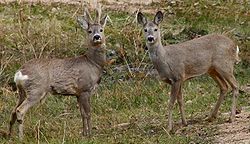Revised taxonomic nomenclature
This section needs additional citations for verification .(June 2023) |
This section needs to be updated.(November 2020) |
| Animal | Scientific name | Proposed new name |
|---|---|---|
 | Vulpes vulpes kurdistanica | Vulpes vulpes |
 | Ovis armeniana | Ovis orientalis anatolicus |
 | Capreolus capreolus armenius | Capreolus capreolus capreolus |
These changes currently[ when? ] affect only official taxonomic nomenclature usage by the Turkish government.